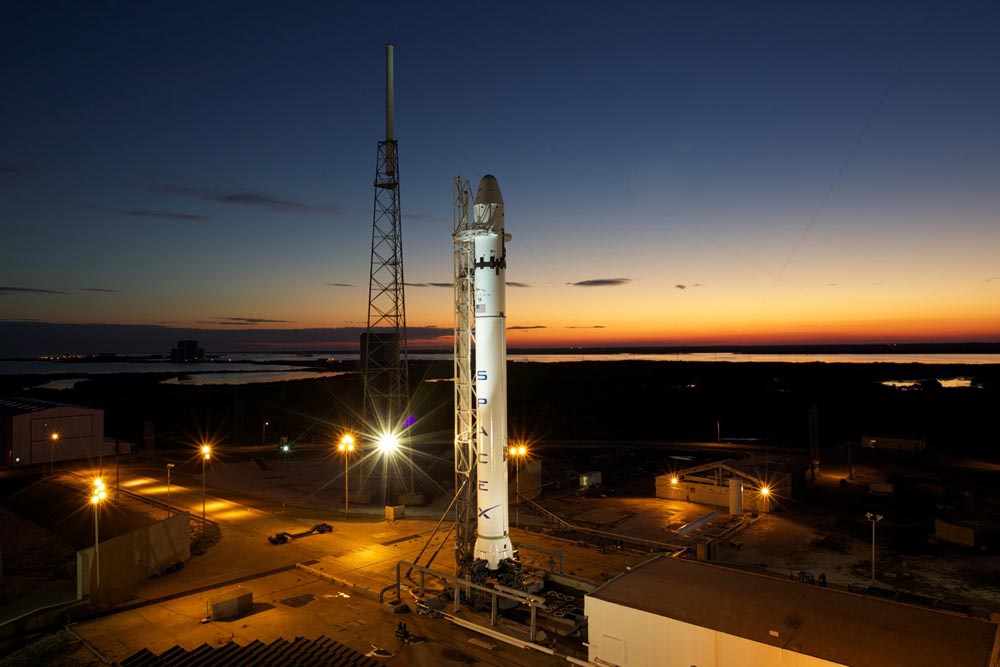SpaceX Rocket Countdown Rehearsal A 'Great Success'

Taking advantage of a picturesque day in the Sunshine State,the privately-developed Falcon 9 rocket came to life Friday afternoon asengineers loaded 75,000 gallons of propellant aboard the vehicle during asimulated countdown.
Friday's countdown wet dress rehearsal was "the smoothesttest we have conducted to date," said Tim Buzza, the Falcon 9 launchdirector.
The booster has spent the last week at Complex40 after being assembled inside a hangar at the pad's southern perimeter.Stormy weather and high winds earlier this week pushed the countdown rehearsalto Friday.
After powering up the 15-story rocket, the launch teamverified all systems were functioning, performed engine purge checks andcleared workers from the launch pad.
About 29 managers and engineers inside SpaceX's LaunchControl Center oversaw the countdown, which began at the T-minus 2 hour, 30minute point.
The transporter/erector, also serving as an umbilical towerand strongback, was partially tilted away from the rocket around 1:30 p.m. EST.Liquid oxygen started flowing into the two-stage Falcon 9 launcher at about 3p.m. EST.
The super-cold oxidizer was loaded into the rocket until thefirst and second stage tanks were 98 percent full, then the launch team toppedoff the liquid oxygen to liftoff levels, where they remained throughout thecountdown, according to SpaceX.
Get the Space.com Newsletter
Breaking space news, the latest updates on rocket launches, skywatching events and more!
The shining white rocket was coated in ice after liquidoxygen was placed on-board.
The Falcon9 was next filled with kerosene fuel, which powers Merlin engines on bothstages of the rocket.
In the final 10 minutes of the countdown, the Falcon 9'snavigation system was aligned for launch, the rocket was transferred tointernal power, the engine steering systems were checked out, and propellanttanks were pressurized at T-minus 40 seconds, according to Buzza.
The countdown clock was stopped at T-minus 10 seconds around5:15 p.m. EST using the pad abort system.
After safing the rocket and launch pad, SpaceX drained theFalcon 9 of propellant and raised the strongback next to the launcher.
"It was a good day," said Elon Musk, SpaceX'sfounder and CEO.
Engineers will spend the next few days carefully reviewingdata from Friday's test. If the results prove satisfactory, SpaceXplans to fuel the rocket again in the coming weeks for another countdownrehearsal that will end with a brief ignition of the Falcon's nine first stageengines for about three-and-a-half seconds.
Unlike Friday's practice countdown, which was unannounced,the engine test will send an unmistakable roar across the Florida spaceport.
The launch date for the inaugural Falcon 9 rocket missionremains unclear, but it is not expected to occur before March 22. Thedemonstration flight's launch window opens at 11 a.m. EDT each day.
SpaceX is developing the Falcon 9 rocket and a spacecraftnamed Dragon under a NASA contract to deliver supplies to the InternationalSpace Station beginning next year.
Since its founding in 2002, SpaceX has launched the smallerFalcon 1 rocket five times, reaching orbit twice.
The company is considered a frontfrunner among commercialfirms competing for the job of carrying astronauts to the International SpaceStation under NASA's new emphasis on private human spaceflight.
- SPACE.com Video Show — The Industrial Revolution in Space
- Space Station 98% Complete with 4 Shuttle Flights Remaining
- Video — SpaceX's Vision for Manned Dragon Spaceship

Join our Space Forums to keep talking space on the latest missions, night sky and more! And if you have a news tip, correction or comment, let us know at: community@space.com.
Stephen Clark is the Editor of Spaceflight Now, a web-based publication dedicated to covering rocket launches, human spaceflight and exploration. He joined the Spaceflight Now team in 2009 and previously wrote as a senior reporter with the Daily Texan. You can follow Stephen's latest project at SpaceflightNow.com and on Twitter.









